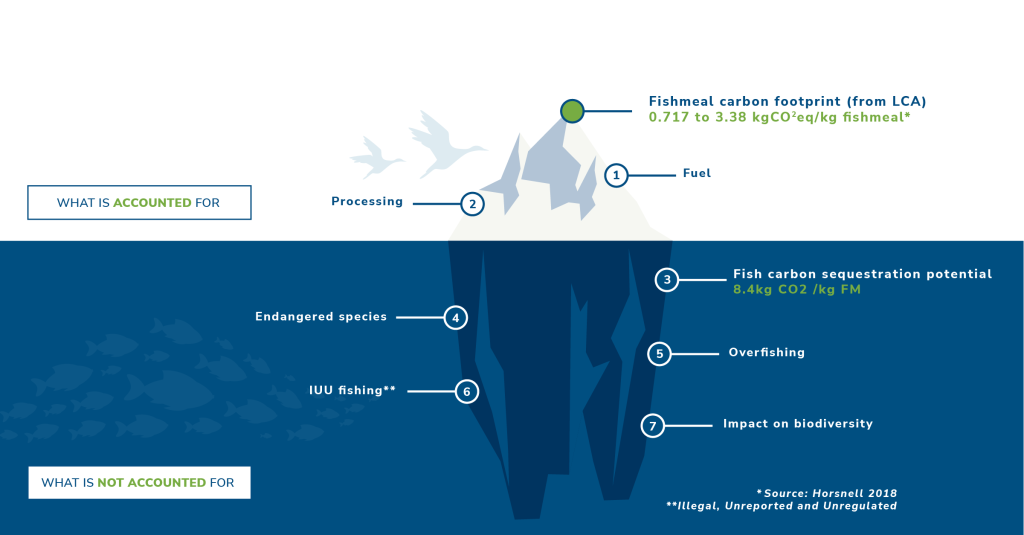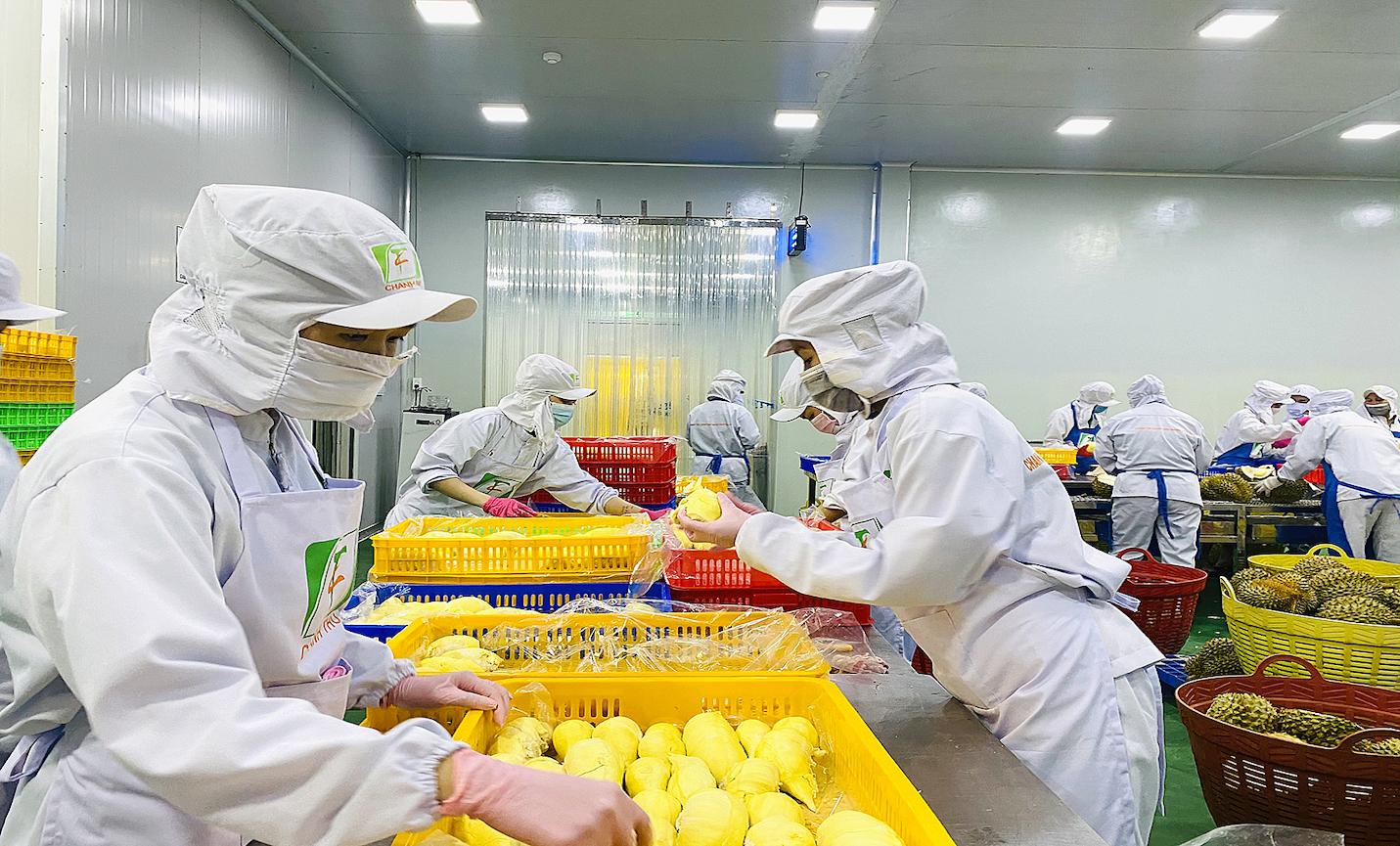The true fishmeal carbon footprint
12 Mon, 2024
The established Life Cycle Analysis (LCA) methodology to assess the fishmeal carbon footprint only accounts for the vessel fuel and post-harvest processing energy while ignoring the carbon sequestration potential of fish.


The ocean’s biological sink and storage is a crucial part of how atmospheric carbon dioxide, CO2, is captured and extracted (in the parlance ‘exported’) out of the carbon cycle. In the discussion of carbon sequestration potential within marine ecosystems, it’s important to understand some key facts and calculations related to fish and their role in organic carbon export and sequestration.
1. Organic Carbon Export:
Organic carbon export refers to the transfer of carbon in organic forms from the surface ocean to the deep sea, primarily through processes like the sinking of particulate organic matter, which can include dead organisms, fecal pellets, and other biological debris. According to Cavan and Hill 2018, the average annual export of organic carbon by marine processes is approximately 8 billion tons of carbon (Gt C). Another study (Shadwick et al, 2023) estimates these 8 billion tons of carbon export capture approximately 30% of human-generated atmospheric carbon dioxide.
2. Fish Contribution to Carbon Sequestration:
Fish contribute significantly to organic carbon export because they produce particulate organic matter, such as dead organisms and fecal pellets, which sink from the surface ocean to the deep sea. Cavan and Hill (2018) stated that fish and fish biomass are responsible for up to 16% of this organic carbon export, which means, fish sequestrated:
16% x 8 = 1.28 Gt C annually.
To convert the sequestered C into its CO2 equivalent, using the molecular weight difference between C and CO2, fish helps take away
1.28 x 3.67 = 4.7 Gt CO2 annually from the atmosphere.
Due to its carbon sequestration potential, fishmeal carbon footprint should add 13 tons CO2eq per ton of fishmeal, to its current LCA value.
The LCA of fishmeal overlooks the intricate nature of biodiversity and various environmental issues. These include overfishing, the unintentional capture of endangered species, and the problem of Illegal, Unreported, and Unregulated (IUU) fishing.
3. Impact of Fish Catching:
Catching fish changes the sequestration potential of ocean fish because it removes individuals that would otherwise contribute to the organic carbon export process. When fish are caught, they are removed from this natural cycle, reducing the amount of particulate organic matter produced and, consequently, the overall carbon sequestration potential. This disruption can lead to higher levels of carbon dioxide remaining in the atmosphere, thereby affecting the global carbon cycle and contributing to climate change.
To calculate the rate of fish being caught relative to the total fish biomass, we use the following formula: Catch Rate=Annual Fish Catch/Total Fish Biomass. With the annual fish catch in 2020 of 90 million tons (FAO) and a total fish biomass of 2 billion tons (University of British Colombia), the annual catch rate is:
90,000,000 / 2,000,000,000 = 4.5%.
This makes the fishing industry releases:
5% x 4.7 = 0.2115 Gt CO2 annually.
4. Fishmeal Production:
The fishmeal industry plays a crucial role in global aquaculture and agriculture, providing a high-protein feed ingredient derived from wild-caught fish. However, this industry also impacts the ocean’s carbon sequestration potential. Since 20% of wild fish caught is used for fishmeal production (USAID, 2016), the fishmeal industry releases
20% x 0.2115 = 0.0423 Gt CO2 annually, which is equivalent to 42 million tons of CO2 per year.
With the annual global production of fishmeal to be 5 million tons per year (FAO, 2022), a ton of fishmeal releases:
42 million tons / 5 million tons = 4 tons of CO2 (eq, 8 times higher than its current LCA calculation).
Comparison
The CO2 released from the fishmeal industry is equivalent to 7.6 million cars driving for a year, 6.7 million families using electricity for a year according to the EPA.
Conclusion
The established Life Cycle Analysis (LCA) methodology to assess the fishmeal carbon footprint only accounts for the vessel fuel and post-harvest processing energy while ignoring the carbon sequestration potential of fish. The LCA of fishmeal overlooks the intricate nature of biodiversity and various environmental issues. These include overfishing, the unintentional capture of endangered species, and the problem of Illegal, Unreported, and Unregulated (IUU) fishing.
Insect protein solves all of these issues. The Black Soldier Fly stands out as a remarkably efficient organism, converting low-value agricultural by-products into high-quality protein that can displace fishmeal. The CO2 footprint of insect meal is mostly below 2 tons of CO2 eq per ton of meal, way below the 8.4 tons attributable to a ton of fishmeal.
The calculations above demonstrate the substantial impact fish have on carbon sequestration in marine ecosystems. By allowing fish to follow their natural course, we can significantly enhance carbon capture, reducing atmospheric CO2 levels.
References
Cavan, E. L., & Hill, S. L. (2018). Global-scale climate patterns, productivity, and the carbon cycle in the ocean. *Global Change Biology, 24*(12), 5314-5323. https://doi.org/10.1111/gcb.16019
Food and Agriculture Organization of the United Nations (FAO). (2022). *The State of World Fisheries and Aquaculture 2022: Towards Blue Transformation*. https://openknowledge.fao.org/server/api/core/bitstreams/9df19f53-b931-4d04-acd3-58a71c6b1a5b/content/sofia/2022/capture-fisheries-production.html
International Fishmeal and Fish Oil Organisation (IFFO). (n.d.). *Aquaculture and its role in feeding the world*. https://www.iffo.com/aquaculture
United States Agency for International Development (USAID). (n.d.). *Aquaculture: A look into the world’s fastest growing food sector*. https://pdf.usaid.gov/pdf_docs/pa00m1t3.pdf
United States Environmental Protection Agency (EPA). (n.d.-a). *Greenhouse gas emissions from a typical passenger vehicle*. https://www.epa.gov/greenvehicles/greenhouse-gas-emissions-typical-passenger-vehicle
United States Environmental Protection Agency (EPA). (n.d.-b). *Greenhouse gases equivalencies calculator: Calculations and references*. https://www.epa.gov/energy/greenhouse-gases-equivalencies-calculator-calculations-and-references
University of British Columbia. (2009). First-ever worldwide estimate of total fish biomass and its impact on marine ecosystems. *Phys.org*. https://phys.org/news/2009-01-first-ever-worldwide-fish-biomass-impact.html
Source: www.entobel.com
Related Post
Freezing Tropical Fruits: Convenient and Effective Solution with Octofrost Machines
Tropical fruits are always a great choice for providing nutrition and fresh flavor to daily meals.
View more
Investment in cold storage needed for proactive export of agricultural products
Before the Lunar New Year, many fruits and agricultural products exported to China were stuck at the border gates, with thousands of containers, and traders neglected to purchase them. However, just after the end of the Lunar New Year, fruit prices skyrocketed, benefiting businesses, which had had cold storage warehouses to store goods before.
View more


